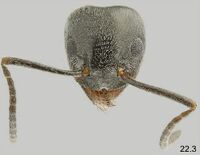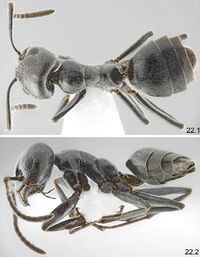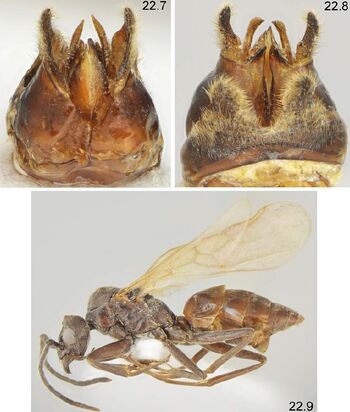Tapinoma festae
| Tapinoma festae | |
|---|---|

| |
| Scientific classification | |
| Kingdom: | Animalia |
| Phylum: | Arthropoda |
| Class: | Insecta |
| Order: | Hymenoptera |
| Family: | Formicidae |
| Subfamily: | Dolichoderinae |
| Genus: | Tapinoma |
| Species: | T. festae |
| Binomial name | |
| Tapinoma festae Emery, 1925 | |
Tapinoma festae is a thermophilous species and it prefers strongly sun-exposed habitats. It was noted from sandy beach areas, oak and pine forests, olive plantations, shores of artificial lakes, sandy river banks, ruderal places in tourist resorts and rarely in shaded valleys with small creeks. Nest were found under stones. In northern Greece, most its records are from low altitude up to 500 m, in southern Greece T. festae is common also at high altitude in mountains, the highest locality was from Psiloritis Mts. on Crete placed at altitude of 1650 m. (Borowiec and Salata 2022)
Identification
Borowiec and Salata (2022) - Within Greece: Tapinoma festae and Tapinoma subboreale form a complex of species with shallow and broad median emargination of clypeus. Workers are very difficult to determine based only on external characters and the best distinguishing character is structure of male genitalia (see Figs 22.7, 8 and 25.5, 7). Additionally, gynes well separate both species, in T. festae they are large with HL 1.063-1.150, HW 1.174-1.254, MW 1.183-1.333 while in T. subboreale gynes are the smallest within the Greek representatives of the genus Tapinoma with HL 0.802-0.873, HW 0.825-0.889, MW 0.889-0.936. Both species are also separated geographically, T. festae is southern species known only from islands north to the southern Ionian Islands. While T. subboreale is northern species not recorded from Greece but known from north Balkan countries. Thus its occurrence in northern provinces of Greece is possible.
Keys including this Species
Distribution
Latitudinal Distribution Pattern
Latitudinal Range: 39.32° to 35.13333°.
| North Temperate |
North Subtropical |
Tropical | South Subtropical |
South Temperate |
- Source: AntMaps, Seifert et al. (2024)
Distribution based on Regional Taxon Lists
Palaearctic Region: Cyprus, Greece (type locality), Iran, Türkiye.
Distribution based on AntMaps
Distribution based on AntWeb specimens
Check data from AntWeb
Countries Occupied
| Number of countries occupied by this species based on AntWiki Regional Taxon Lists. In general, fewer countries occupied indicates a narrower range, while more countries indicates a more widespread species. |

|
Estimated Abundance
| Relative abundance based on number of AntMaps records per species (this species within the purple bar). Fewer records (to the left) indicates a less abundant/encountered species while more records (to the right) indicates more abundant/encountered species. |

|
Biology
Castes
Queen
Images from AntWeb
   
| |
| Queen. Specimen code casent0904018. Photographer Z. Lieberman. | Owned by MSNG. |
Male
Nomenclature
The following information is derived from Barry Bolton's Online Catalogue of the Ants of the World.
- festae. Tapinoma simrothi subsp. festae Emery, 1925d: 51, fig. 4 (q.m.) GREECE. Raised to species: Lush, 2009: 114.
Unless otherwise noted the text for the remainder of this section is reported from the publication that includes the original description.
Description
Worker
Borowiec and Salata (2022) - Small to moderately large, polymorphic but with intermediate forms between the smallest and the largest workers: the largest workers: HL: 0.968-1.031 (mean 0.991); HW: 0.944-1.033 (mean 0.984); SL: 0.933-0.971 (mean 0.954); EL: 0.254-0.257 (mean 0.256); ML: 1.26-1.35; MW: 0.62-0.71; the smallest workers: HL: 0.738-0.928 (mean 0.808); HW: 0.619-0.873 (mean 0.707); SL: 0.689-0.827 (mean 0.736); EL: 0.198-0.235 (mean 0.209); ML: 0.89-1.13; MW: 0.43-0.57. Color. Body brown to black, gena often slightly paler than resto head, yellowish brown, antennae and legs brown, coxa often slightly paler brown than femora, in pale specimens tibiae yellowish brown, tarsi always paler than femora yellow to yellowish brown. Head. In major workers approximately as long as wide, in minor workers 1.1-1.2 times as long as wide, widest in basal 1/3 length then softly converging anterad, occipital corners rounded, occipital margin concave. Clypeus microreticulated but shiny, triangularly extended to the front, in the middle moderately emarginate to 0.14-0.18 length of clypeus, shape of emargination semicircular to slightly triangular; sides of clypeus deeply concave, posterior margin rounded, surface covered with dense appressed hairs, explanate anterior margin close to median emargination with one or two pairs of erected setae and 2-4 long and several decumbent short setae mostly extending behind margin of clypeus but usually not extending behind margins of median emargination. Head distinctly microreticulated but shiny, with moderately long and moderately dense appressed pubescence not covering head surface, erected setae absent, ventral side of head with0ut erected setae). Scape moderately elongate, in major workers 0.9-1.0 in minor workers 1.0- 1.1 times as long as width of head, very thin, only slightly widened from base to apex, its surface microreticulate but shiny, with short and moderately dense appressed pubescence, erected setae absent. Funicular segments elongate, thin, first segment 2.3 times as long as wide and 1.3 times as long as second segment which is 1.8 times as long as wide, the rest of funicular segments s longer than broad. Eyes big, placed in the middle of frontal surface of head, almost circular, 0.26 length of head. Mandibles long, without striation, teeth of masticatory margin gradually smaller posterad. Mesosoma. Elongate, 1.8-2.1 times as long as wide, dorsally and laterally distinctly microreticulated but shiny, sometimes sides of propodeum with slightly dull background, with short and moderately dense appressed pubescence. In lateral view pronotum and mesonotum regularly convex, propodeum forms obtuse angle, mesonotal groove moderately deep. Mesosomal dorsum lacking erected setae. Waist and gaster. Petiolar scale small, thin, hidden under protruding anterad anterior face of first gastral tergite. Gaster longer than mesosoma, tergites distinctly microreticulated sometimes tending to form transverse sculpture, surface shiny, covered with moderately long and dense appressed pubescence, first three tergites lacking erected setae, sternites with median keel. Legs. Moderately long, tibiae distinctly widened from base to apex, mid and hind tibiae with very long, sharp apical spur, first segment of tarsi longer than subsequent segments combined, surface covered withmoderately long and moderately dense appressed hairs, erected setae absent, inner margin of tibiae lacking row of thorns.
Queen
Borowiec and Salata (2022) - Large: HL: 1.063-1.150 (mean 1.097); HW: 1.174-1.254 (mean 1.220); SL: 0.949-1.012 (mean 0.978); ML: 2.07-2.17; MW: 1.18-1.33; HL/HW: 0.860-0,941 (mean 0.899); SL/HW: 0.787-0.808 (mean 0.802); ML/MW: 1.625-1.747 (mean 1.681).
References
- Berville, L., Hefetz, A., Espadaler, X., Lenior, A., Renuuci, M., Blight, O., Provost, E. 2013. Differentiation of the ant genus Tapinoma (Hymenoptera: Formicidae) from the Mediterranean Basin by species-specific cuticular hydrocarbon profiles. Myrmecological News 18: 77-92.
- Borowiec, L. 2014. Catalogue of ants of Europe, the Mediterranean Basin and adjacent regions (Hymenoptera: Formicidae). Genus (Wroclaw) 25(1-2): 1-340.
- Borowiec, L., Salata, S. 2022. A monographic review of ants of Greece (Hymenoptera: Formicidae). Vol. 1. Introduction and review of all subfamilies except the subfamily Myrmicinae. Part 1: text. Natural History Monographs of the Upper Silesian Museum 1: 1-297.
- Cantone S. 2018. Winged Ants, The queen. Dichotomous key to genera of winged female ants in the World. The Wings of Ants: morphological and systematic relationships (self-published).
- Demetriou, J., Georgiadis, C., Ralli, V., Salata, S., Borowiec, L. 2024. Setting the record straight: a re-examination of ants (Hymenoptera: Formicidae) from Cyprus deposited at the Museum of Zoology of Athens. Zootaxa 55231, 49–69 (doi:10.11646/zootaxa.5523.1.3).
- Kiran, K., Karaman, C. 2020. Additions to the ant fauna of Turkey (Hymenoptera, Formicidae). Zoosystema 42(18), 285-329 (doi:10.5252/zoosystema2020v42a18).
- Lush, M.J. 2009. Some ant records from the Middle East. Zoology in the Middle East 47: 114-116.
- Salata, S., Borowiec, L., Trichas, A. 2020. Review of ants (Hymenoptera: Formicidae) of Crete, with keys to species determination and zoogeographical remarks. Monographs of the Upper Silesian Museum No 12: 5–296 (doi:10.5281/ZENODO.3738001).
- Seifert, B. 2016. Clypeal excision in Tapinoma Förster, 1850 ants is adaptive (Hymenoptera: Formicidae). Contributions to Entomology 66, 125-129 (doi:10.21248/CONTRIB.ENTOMOL.66.1.125-129).
- Seifert, B., Kaufmann, B., Fraysse, L. 2024. A taxonomic revision of the Palaearctic species of the ant genus Tapinoma Mayr 1861 (Hymenoptera: Formicidae). Zootaxa 5435(1), 1-74 (doi:10.11646/zootaxa.5435.1.1).
References based on Global Ant Biodiversity Informatics
- Baroni Urbani C. 1977. Katalog der Typen von Formicidae (Hymenoptera) der Sammlung des Naturhistorischen Museums Basel (2. Teil). Mitt. Entomol. Ges. Basel (n.s.) 27: 61-102.
- Borowiec L. 2014. Catalogue of ants of Europe, the Mediterranean Basin and adjacent regions (Hymenoptera: Formicidae). Genus (Wroclaw) 25(1-2): 1-340.
- Borowiec L., and S. Salata. 2012. Ants of Greece - Checklist, comments and new faunistic data (Hymenoptera: Formicidae). Genus 23(4): 461-563.
- Collingwood, C. A. 1993. A Comparitive Study of the Ant Fauna of Five Greek Islands. Biologia Gallo-hellenica. 20,1:191-197
- Collingwood, C. A. "A comparative study of the ant fauna of five Greek islands." Biologia Gallo-Hellenica 20 (1993): 191-197.
- Czechowski W., A. Radchenko, W. Czechowska and K. Vepsäläinen. 2012. The ants of Poland with reference to the myrmecofauna of Europe. Fauna Poloniae 4. Warsaw: Natura Optima Dux Foundation, 1-496 pp
- Emery C. 1925. Revision des espèces paléarctiques du genre Tapinoma. Revue Suisse de Zoologie 32: 45-64.
- Ghahari H., and C. A. Collingwood. 2013. A study on the ants (Hymenoptera: Vespoidea: Formicidae) from Western Iran. Acta Phytopathologica et Entomologica Hungarica 48 (1): 155164.
- Lush M. J. 2009. Some ant records (Hymenoptera; Formicidae) from the Middle East. Zoology in the Middle East 47: 114-116.
- Lush M.J. 2009. Some ant records (Hymenoptera; Formicidae) from the Middle East. Zoology in the Middle East 47: 114-116.
- Salata S., L. Borowiec, and A.Trichas. 2018. Taxonomic Revision of the Cretan Fauna of the Genus Temnothorax Mayr, 1861 (Hymenoptera: Formicidae), with Notes on the Endemism of Ant Fauna of Crete. Annales Zoologici (Warsaw) 68(4): 769-808.
- Salata S., and L Borowiec. 2017. Species of Tetramorium semilaeve complex from Balkans and western Turkey, with description of two new species of (Hymenoptera: Formicidae: Myrmicinae). Annales Zoologici (Warsaw) 62:279–313.
- Salata S., and L. Borowiec. 2018. A new species of the ant genus Lasius Fabricius, 1804 from Crete (Hymenoptera, Formicidae). ZooKeys 789: 139–159.
- Salata S., and L. Borowiec. 2018. Taxonomic and faunistic notes on Greek ants (Hymenoptera: Formicidae). Annals of the Upper Silesian Museum in Bytom Entomology 27: 1-51.
- Salata S., and L. Borowiec. 2019. Preliminary division of not socially parasitic Greek Temnothorax Mayr, 1861 (Hymenoptera, Formicidae) with a description of three new species. ZooKeys 877: 81-131.
- Shattuck S. O. 1994. Taxonomic catalog of the ant subfamilies Aneuretinae and Dolichoderinae (Hymenoptera: Formicidae). University of California Publications in Entomology 112: i-xix, 1-241.



